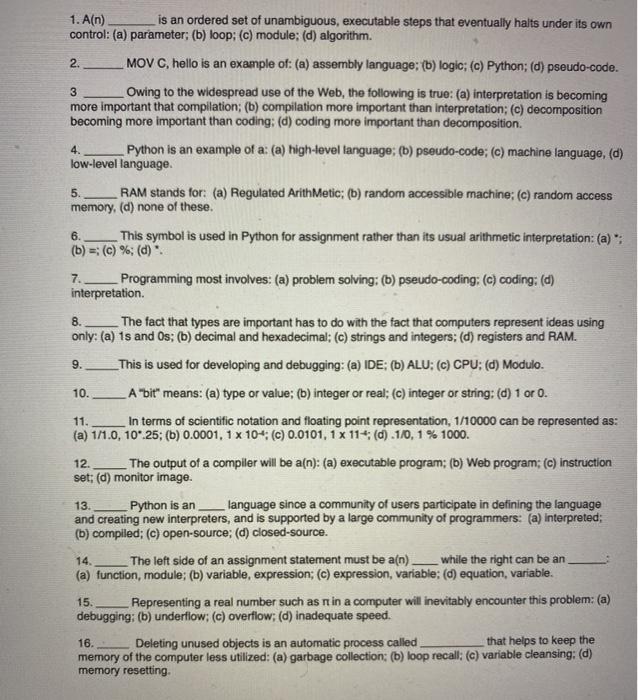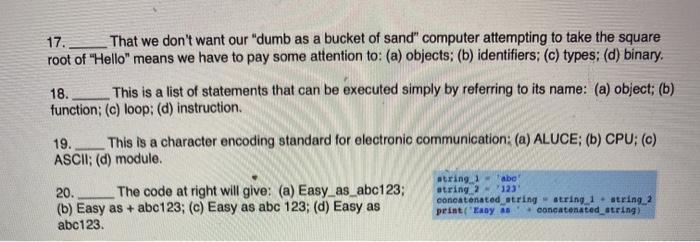2. 4. 5. 6. 8. 1. A(n) is an ordered set of unambiguous, executable steps that eventually halts under its own control: (a) parameter; (b) loop: (c) module; (d) algorithm. MOV C, hello is an example of: (a) assembly language: (b) logic; (c) Python; (d) pseudo-code. 3 Owing to the widespread use of the Web, the following is true: (a) interpretation is becoming more important that compilation; (b) compilation more important than interpretation; (c) decomposition becoming more important than coding; (d) coding more important than decomposition. Python is an example of a: (a) high-level language; (b) pseudo-code; (c) machine language, (d) low-level language RAM stands for: (a) Regulated Arithmetic; (b) random accessible machine: (c) random access memory, (d) none of these. This symbol is used in Python for assignment rather than its usual arithmetic interpretation: (a); (b) = (c) %; (d) 7. Programming most involves: (a) problem solving: (b) pseudo-coding: (c) coding: (d) interpretation The fact that types are important has to do with the fact that computers represent ideas using only: (a) 1s and Os; (b) decimal and hexadecimal; (c) strings and integers; (d) registers and RAM. This is used for developing and debugging: (a) IDE; (b) ALU: (C) CPU; (d) Modulo. A bit" means: (a) type or value; (b) integer or real; (C) integer or string: (d) 1 or 0. In terms of scientific notation and floating point representation, 1/10000 can be represented as: (a) 1/1.0, 10:25; (b) 0.0001, 1 x 10+: (c) 0.0101, 1 x 114; (d) 1/0,1% 1000. The output of a compiler will be a[n): (a) executable program; (b) Web program; (c) instruction set: (d) monitor image. Python is an language since a community of users participate in defining the language and creating new interpreters, and is supported by a large community of programmers: (a) interpreted: (b) compiled; (c) open-source; (d) closed-source. The left side of an assignment statement must be a[n) ___ while the right can be an (a) function, module; (b) variable, expression: (c) expression, variable: (d) equation, variable. Representing a real number such as it in a computer will inevitably encounter this problem: (a) debugging; (b) underflow: (c) overflow; (d) inadequate speed, Deleting unused objects is an automatic process called that helps to keep the memory of the computer less utilized: (a) garbage collection; (b) loop recall: (c) variable cleansing: (d) memory resetting 9. 10. 11. 12. 13. 14. 15. 16. 17. That we don't want our "dumb as a bucket of sand" computer attempting to take the square root of "Hello" means we have to pay some attention to: (a) objects: (b) identifiers; (c) types: (d) binary. 18. This is a list of statements that can be executed simply by referring to its name: (a) object; (b) function; (c) loop: (d) instruction 19. This is a character encoding standard for electronic communication: (a) ALUCE:(b) CPU; (c) ASCII; (d) module. string 1 - Fabe 20. The code at right will give: (a) Easy_as_abc123; string? - 123 (b) Easy as + abc123; (c) Easy as abc 123; (d) Easy as concatenated string - string 1. string 2 print('any as concatenated_string) abc123








